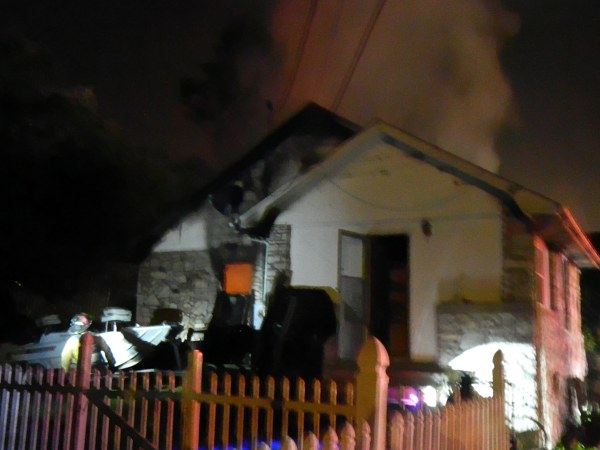
The historic Luther Brannon House was damaged, but no injuries were reported in this house fire on Oak Ridge Turnpike early Monday morning. Gen. Leslie R. Groves, commander of the top-secret Manhattan Project during World War II, once lived here, and he had his headquarters in this single-story bungalow, which was built in 1941 and soon acquired by the federal government.
Note: This story was last updated at 1 p.m. July 8.
A historic house that once served as a home and headquarters for Gen. Leslie R. Groves during the top-secret Manhattan Project in World War II was heavily damaged in a fire early Monday morning.
No injuries were reported in the house fire, which was reported at 1:36 a.m. Monday.
The one-story stone bungalow at 151 Oak Ridge Turnpike is known as the Luther Brannon House, and it’s just west of Melton Lake Drive and next to the U.S. Department of Energy’s Office of Scientific and Technical Information. It’s listed on the National Register of Historic Places, and it was the first home in Oak Ridge to be privately owned.
Oak Ridge Fire Department Chief Darryl Kerley said it appears that the Monday morning fire started in the kitchen. Owner Danny Brannon and his daughter were returning from a movie when they found the home on fire. They opened the front door and found the home filled with hot, black smoke, an ORFD press release said. Brannon opened the basement door to find that area clear, but he found fire coming from the kitchen window in the back of the house. The family called 911.
“We have not been able to determine what the cause is,†Kerley said. The Fire Department is waiting for an insurance company, which is sending an investigator and claims adjuster, before continuing its investigation.

The fire early Monday morning destroyed the dining room and the kitchen in the back of the house. The rest of the home was damaged by heat and smoke.
The home was built by Owen Hackworth in 1941. Hackworth was a longtime resident of the Clinch River Valley.
The Luther Brannon House was acquired by the federal government in 1942, according to the home’s registration form for the National Park Service’s National Register of Historic Places. Groves, the commander of the Manhattan Project, lived at the home and kept his headquarters there until administration buildings were completed, according to a property documentation form filed with the National Register of Historic Places in 1991. The Manhattan Project built the world’s first atomic bombs.
The home was one of the most modern structures in the valley when purchased by the federal government, according to the property documentation form.
“Built near the community of Elza, the house is the only extant residence associated with the original valley settlements,†the form said.
As of 1991, there were only three pre-World War II dwellings left in Oak Ridge: the Luther Brannon House; the Freels Bend cabin, a 19th-century log structure located near the Clark Center Park in south Oak Ridge and the city’s oldest building; and the J.B. Jones House built around 1920 on Old Edgemoor Road across from the Bull Run Steam Plant.
There are also two churches that pre-date the construction of Oak Ridge: the George Jones Memorial Baptist Church in the former Wheat community in west Oak Ridge and the New Bethel Baptist Church on Bethel Valley Road near Oak Ridge National Laboratory.
The Luther Brannon House is significant for its affiliation with the early development of Oak Ridge and its association with Groves. It’s the only pre-war house that remains inside the city proper, and it’s the only confirmed residence of any of the key personalities associated with the Manhattan Project, the National Historic Register filing said.
The kitchen is in the back of the house, and high flames were reported coming from that section of the home on Monday morning, including out of four windows. Kerley said firefighters had the flames knocked down in about six to eight minutes.
“They put it out really quick,†Kerley said.
The fire had extended into the dining room.
All fire units responded, except those from Station No. 4 at East Tennessee Technology Park in west Oak Ridge. Station Four crews responded to a medical call inside the city while other crews battled the Luther Brannon House fire. Kerley said three fire engines, one tower truck, the rescue truck, and the battalion chief, as well as the Anderson County ambulance service, were sent to the scene.
Firefighters remained on the scene for some time, clearing smoke and keeping an eye on hot spots.
Kerley said the Luther Brannon House will have to be completely rebuilt inside. He said the stone house held the heat from the Monday morning fire really well. The kitchen and dining room are destroyed, and the rest of home is damaged from heat and smoke, Kerley said.
But he said the owner wants to rebuild it.
The American Red Cross responded to the fire and gave Brannon and his teenaged daughter a place to stay for three days and will help with food and clothing.
Luther Brannon House
The Luther Brannon House is named after Luther Brannon, whose family has lived in the house since 1946. Danny Brannon is Luther Brannon’s grandson.
Luther Brannon came to Oak Ridge in September 1943 to manage the Chevrolet dealership on the town site, according to the National Historic Register registration. He worked for Chevrolet until 1950, when he went into business for himself. Danny Brannon said his grandfather, a businessman, was known as “Lefty.â€
“Brannon was one of the private concessionaires who came to Oak Ridge (as) a part of the Army’s plan to provide a semblance of normalcy to townsite residents under extraordinary conditions that existed until the city was incorporated in 1959,†the registration form said.
Besides its wartime connections, the Luther Brannon House is also important in post-war history because it represents an important step in the city’s move toward independence from government control.
“In preparation for incorporation of the townsite, all houses in Oak Ridge were released for sale to the public in 1956,†the registration form said. “Brannon’s house was slated for demolition because of its location in a designated commercial area.â€
The house is the only home in the middle of a commercial district on the south side of Oak Ridge Turnpike.
“Mrs. Brannon wrote to War Department officials in Washington, D.C., for permission to remain in her house,†the registration said. “The Brannons were granted special permission to purchase the house and were the very first homeowners in Oak Ridge.â€
In 2001, The Oak Ridger newspaper reported that 180 of the pre-World War II houses were used to alleviate the severe housing shortage on the 59,000-acre military reservation in Oak Ridge during the war. The city’s population quickly swelled to 75,000 during the frenzied top-secret effort to build the world’s first atomic bombs, and homes, businesses, and military activities replaced acres of farmland and several rural communities. Almost all of the remaining pre-World War II homes were torn down after the war, The Oak Ridger said.
More information will be added as it becomes available.










Peter Scheffler says
How unfortunate! I have often wondered what that house was, as it was quite unlike everything else around it. I do hope it is rebuilt.
johnhuotari says
I knew a bit of the history, but was unaware of most of it. The fire chief did say the owner plans to rebuild.
mary connolly says
What an interesting story! Thanks John.
johnhuotari says
You’re welcome, Mary. I’m glad everyone was okay, and it sounds like the house will be rebuilt.
Mack Bailey says
There was a fire in this house about 10 years ago, on a Sunday, in the basement, dryer lint and cigarette.
Ray Evans says
Mack
Wasn’t there a carport fire a few years ago as well.